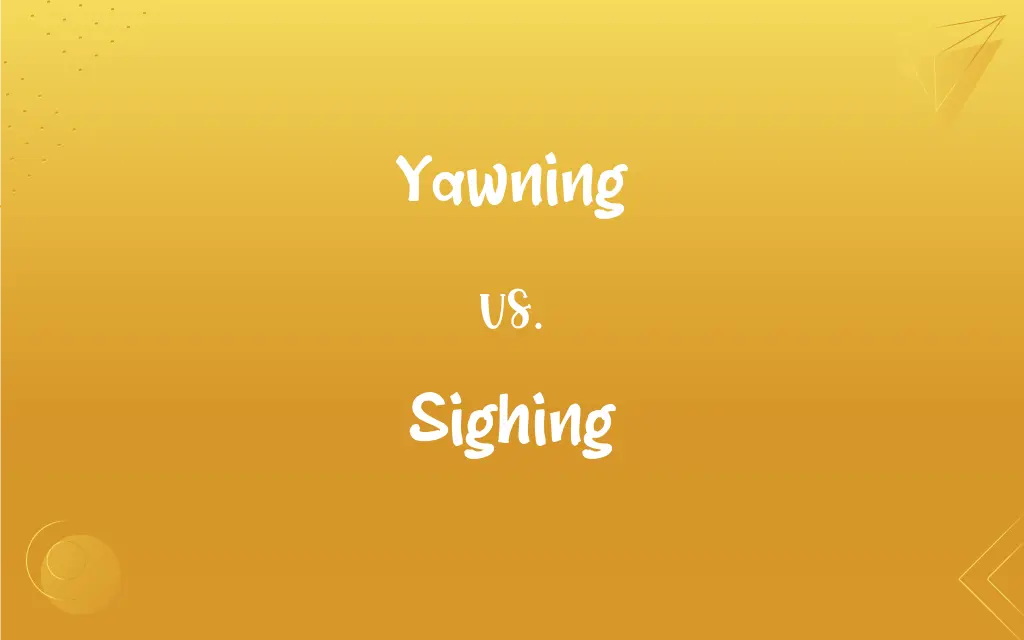Yawning vs. Sighing: What's the Difference?
Edited by Janet White || By Harlon Moss || Updated on October 26, 2023
Yawning is an involuntary opening of the mouth, often due to tiredness; sighing is exhaling deeply, often expressing emotions like relief or sadness.

Key Differences
Yawning is an involuntary act, often associated with tiredness or boredom, characterized by a wide opening of the mouth. Sighing is a deep exhale, usually expressing emotions such as relief, sadness, or frustration.
The act of yawning is believed to help increase oxygen intake and cool the brain. Sighing, on the other hand, is thought to reset breathing patterns and express emotions.
Yawning is often contagious among humans and even some animals. Sighing, however, is a personal expression and typically not contagious.
Yawning can occur when one is tired, bored, or sees someone else yawn. Sighing is often a response to emotional states, stress, or a need to reset breathing.
While yawning involves a wide opening of the mouth and sometimes stretching of the body, sighing involves a deep inhale followed by a longer, audible exhale.
ADVERTISEMENT
Comparison Chart
Definition
Involuntary opening of the mouth
Exhaling deeply, often expressing emotions
Trigger
Tiredness, boredom, contagiousness
Emotional states, stress
Physical Action
Wide mouth opening, sometimes body stretching
Deep inhale, longer exhale
Purpose/Believed Benefit
Increase oxygen intake, cool the brain
Reset breathing, express emotions
Contagiousness
Often contagious
Not contagious
ADVERTISEMENT
Yawning and Sighing Definitions
Yawning
Contagious action triggering a similar response in others.
Her yawning made everyone else in the room yawn.
Sighing
Exhaling longer than usual due to frustration or sadness.
He sighed deeply, frustrated with the delay.
Yawning
Involuntary opening of the mouth due to tiredness.
She kept yawning during the long lecture.
Sighing
A way to reset irregular breathing.
After the sprint, she was sighing to catch her breath.
Yawning
Believed to help increase oxygen intake.
He was yawning to stay alert during the meeting.
Sighing
Not contagious but often a personal emotional expression.
Alone in her room, she sighed, feeling overwhelmed.
Yawning
Can involve stretching and is often seen in animals too.
The yawning cat stretched lazily in the sun.
Sighing
Deep exhale expressing emotions.
She sighed with relief after hearing the good news.
Yawning
A reflex often associated with boredom.
His yawning indicated his lack of interest.
Sighing
Can be audible, signaling emotions nonverbally.
Her sighing during the conversation showed her impatience.
Yawning
Gaping open; cavernous
A yawning abyss.
Sighing
To exhale audibly in a long deep breath, as in weariness or relief.
FAQs
Why do people sigh?
To express emotions or reset breathing.
Do all animals yawn?
Many, but not all, animals yawn.
Is yawning a sign of lack of oxygen?
It can be, as it helps increase oxygen intake.
Can yawning be suppressed?
It's difficult but can be momentarily stifled.
Is sighing always due to sadness?
No, it can express a range of emotions.
Is sighing rude?
It can be perceived as such in some contexts.
Why is yawning contagious?
It's believed to be a social empathy response.
Do babies yawn?
Yes, even fetuses yawn.
Does yawning mean someone is uninterested?
Not always, it can just indicate tiredness.
Are yawns shorter for animals?
It varies between species.
Can yawning be a reflex to bright light?
Yes, some people yawn in response to bright light.
Does sighing have a social function?
It can nonverbally communicate emotions.
Does sighing help with stress?
It can be a release mechanism for stress.
Is sighing bad for health?
Not usually, unless excessive or due to health issues.
Can sighing indicate medical issues?
Excessive sighing might, but not usually.
What triggers yawning besides tiredness?
Boredom, seeing someone else yawn.
Why do we sigh more when tired?
To regulate breathing and express fatigue.
Can sighing be a habit?
Yes, some people sigh habitually.
What's the longest a yawn can last?
Typically, a few seconds.
Can sighing be controlled?
To some extent, but it's often involuntary.
About Author
Written by
Harlon MossHarlon is a seasoned quality moderator and accomplished content writer for Difference Wiki. An alumnus of the prestigious University of California, he earned his degree in Computer Science. Leveraging his academic background, Harlon brings a meticulous and informed perspective to his work, ensuring content accuracy and excellence.
Edited by
Janet WhiteJanet White has been an esteemed writer and blogger for Difference Wiki. Holding a Master's degree in Science and Medical Journalism from the prestigious Boston University, she has consistently demonstrated her expertise and passion for her field. When she's not immersed in her work, Janet relishes her time exercising, delving into a good book, and cherishing moments with friends and family.
































































